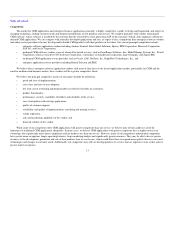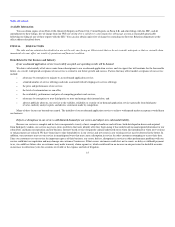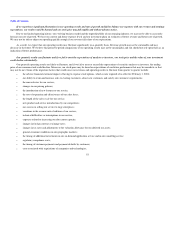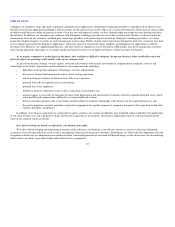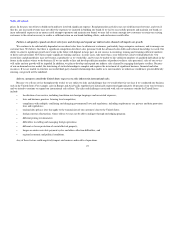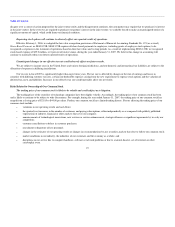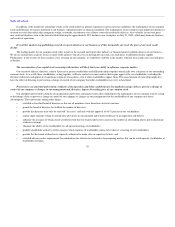Salesforce.com 2006 Annual Report Download - page 23
Download and view the complete annual report
Please find page 23 of the 2006 Salesforce.com annual report below. You can navigate through the pages in the report by either clicking on the pages listed below, or by using the keyword search tool below to find specific information within the annual report.
Table of Contents
Our success also depends on the willingness of third-party developers to build applications that are complementary to our service. Without the
development of these applications, both current and potential customers may not find our service sufficiently attractive. In fiscal 2006, we introduced the
AppExchange directory, a central online marketplace for on-demand applications that we host for our customers, developers and partners to exchange custom
on-demand applications that are built on, or can integrate with, our service. These custom applications, some of which are not CRM-related, include
applications ranging from expense management to purchasing to recruiting. Although we do not presently charge for use of the AppExchange directory, it is
uncertain whether this service will be accepted and adopted by our customers, developers and partners or will increase the demand for subscriptions to our
service.
We have limited history with our subscription model to accurately predict the rate of customer subscription renewals and the impact these renewal
rates will have on our future revenue or operating results.
Our customers have no obligation to renew their subscriptions for our service after the expiration of their initial subscription period and in fact, some
customers have elected not to do so. In addition, our customers may renew for a lower priced edition of our service or for fewer subscriptions. We have
limited historical data with respect to rates of customer subscription renewals, particularly for our enterprise customers who purchase a large number of
subscriptions under multi-year contracts, so we cannot accurately predict customer renewal rates. Our customers' renewal rates may decline or fluctuate as a
result of a number of factors, including their dissatisfaction with our service and their ability to continue their operations and spending levels. If our customers
do not renew their subscriptions for our service, our revenue will decline and our business will suffer.
Our future success also depends in part on our ability to sell additional features and services, more subscriptions or enhanced editions of our service to
our current customers. This may require increasingly sophisticated and costly sales efforts that are targeted at senior management. If these efforts are not
successful, our business may suffer.
Our growth could strain our personnel resources and infrastructure, and if we are unable to implement appropriate controls and procedures to
manage our growth, we may not be able to successfully implement our business plan.
We are currently experiencing a period of increasing headcount and rapid growth in our operations, which has placed, and will continue to place, to the
extent that we are able to sustain such growth, a significant strain on our management, administrative, operational and financial infrastructure. We anticipate
that further growth will be required to address increases in our customer base, as well as our expansion into new geographic areas.
Our success will depend in part upon the ability of our senior management to manage this growth effectively. To do so, we must continue to hire, train
and manage new employees as needed. If our new hires perform poorly, or if we are unsuccessful in hiring, training, managing and integrating these new
employees, or if we are not successful in retaining our existing employees, our business may be harmed. To manage the expected growth of our operations
and personnel, we will need to continue to improve our operational, financial and management controls and our reporting systems and procedures. The
additional headcount and capital investments we are adding will increase our cost base, which will make it more difficult for us to offset any future revenue
shortfalls by offsetting expense reductions in the short term. If we fail to successfully manage our growth, we will be unable to execute our business plan.
We derive a significant portion of our revenue from small businesses, which have a greater rate of attrition and non-renewal than medium-sized
and large enterprise customers.
Our small business customers, which we consider to be companies with fewer than 200 employees, typically have shorter initial subscription periods
and, based on our limited experience to date, have had a higher rate of attrition and non-renewal as compared to our medium-sized and large enterprise
customers. If we cannot replace our small business customers that do not renew their subscriptions for our service with new customers quickly enough, our
revenue could decline.
20





